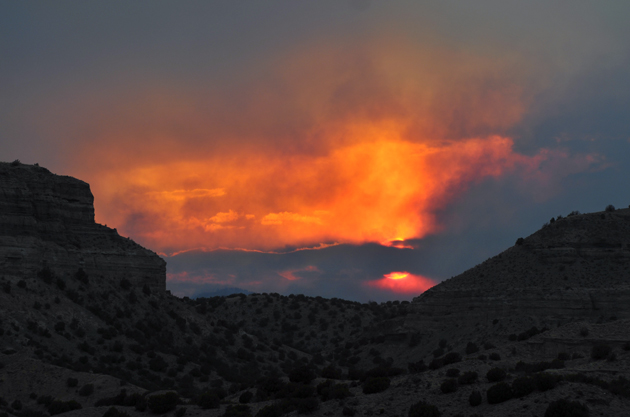
Fort Berthold in North DakotaAbrahm Lustgarten/ProPublica
This story first appeared on the ProPublica website.
Native Americans on an oil-rich North Dakota reservation have been cheated out of more than $1 billion by schemes to buy drilling rights for lowball prices, a flurry of recent lawsuits assert. And, the suits claim, the federal government facilitated the alleged swindle by failing in its legal obligation to ensure the tribes got a fair deal.
This is a story as old as America itself, given a new twist by fracking and the boom that technology has sparked in North Dakota oil country. Since the late 1800s, the U.S. government has appropriated much of the original tribal lands associated with the Fort Berthold reservation in North Dakota for railroads and white homesteaders. A devastating blow was delivered when the Army Corps of Engineers dammed the Missouri River in 1953, flooding more than 150,000 acres at the heart of the remaining reservation. Members of the Three Affiliated Tribes—the Mandan, Hidatsa and Arikara—were forced out of the fertile valley and up into the arid and barren surrounding hills, where they live now.
But that last-resort land turns out to hold a wealth of oil, because it sits on the Bakken Shale, widely believed to be one of the world’s largest deposits of crude. Until recently, that oil was difficult to extract, but hydraulic fracturing, combined with the ability to drill a well sideways underground, can tap it. The result, according to several senior tribal members and lawsuits filed last November and early this year in federal and state courts, has been a land grab involving everyone from tribal leaders accused of enriching themselves at the expense of their people, to oil speculators, to a New York hedge fund, to the federal government’s Bureau of Indian Affairs.
The rush to get access to oil on tribal lands is part of the oil industry’s larger push to secure drilling rights across the United States. Recent estimates show that the U.S. contains vast quantities of oil and gas. As fracking has opened new fields to drilling, and the U.S. has striven to get more of its energy from within its borders, leases from Louisiana to Pennsylvania have been gobbled up. Now the pressure is increasing on one of the last sizeable holdouts—lands owned by Native Americans.
A review of tribal and federal records as well as lawsuit documents reveals a dizzying array of lowball, non-competitive deals brokered by numerous companies, often entwined with the tribal council and with individual landholders on the reservation. But at heart the alleged practices are simple: Tribal leaders and outsiders set up companies to buy drilling rights cheap and flip them later for spectacular profits—in one case earning as much as a 200-fold return in just four years.
“Hundreds of millions of dollars were lost,” said Tex Hall, the current chairman of the Three Affiliated Tribes, in an interview. “It’s just a huge loss and we’ll never get it back.”
At the center of that particular alleged scheme, according to one of the suits, was Spencer Wilkinson, Jr., longtime manager of 4 Bears Casino, a time-worn warehouse of slot machines, swirling cigarette smoke and stained carpets that serves as the reservation’s entertainment nexus and its financial hub. Wilkinson also sat on the board of the tribe’s development corporation, where he was charged with finding new opportunities to enhance the economy of the reservation.
According to interviews with tribal members, former employees of the Three Affiliated Tribes, and a class action lawsuit filed in federal district court in Bismarck, ND against Wilkinson and others, Wilkinson used his access to casino funds—and to the development corporation—to gain influence and craft an oil deal that would leave him one of the richest men on the reservation.
In 2006 he became an owner of a company, Dakota-3, with Richard Woodward, a white consultant who, records show, was receiving more than $20,000 a month from tribal funds for his work at the development corporation. Together, the suit and other legal filings allege, Wilkinson and Woodward planned to raise money and buy up rights to much of the remaining land not yet slated for drilling, all the while maintaining their work with the tribes and employing Wilkinson’s relationship with the council to help get the oil leases approved.
Leases for oil rights generally work like this: A company purchases the right to drill for oil underneath an acre of land by paying a one-time upfront payment, called a bonus, and a percentage of the profits earned on the well, known as a royalty. On Indian lands additional laws also apply, dictating who can negotiate for whom and how the government has to oversee the agreements.
Wilkinson declined to comment and Woodward could not be reached. Wilkinson has filed a motion to dismiss the case. The suit alleges that Wilkinson and others aided and abetted the U.S. government in failing to fulfill its fiduciary responsibility to the tribes; Wilkinson’s motion argues, among other things, that the government had no such responsibility. Woodward has not yet filed a response to the suit in court.
Many details of Dakota-3’s deals remain murky. There is limited transparency into tribal government affairs, no public access to documents, no annual reporting on accounts, and limited communication about what tribal council members discuss in their meetings.
But, according to separate lawsuits and records filed with the North Dakota Secretary of State, Dakota-3 partnered with an Oklahoma-based oil speculator named Robert Zinke and his company Zenergy to buy leases and form additional joint venture companies. Documents from two law suits mention the involvement of the New York based hedge fund Och-Ziff Capital Management Group but do not specify the firm’s role. The hedge fund is publicly traded and, according to its web site, has more than $33 billion under management.
A spokesman for Och-Ziff declined to comment, and Zinke did not return a telephone message.
The interlinked companies, the documents show, purchased drilling rights to some 42,500 acres of lands owned by individuals and families through dozens of separate small deals. Those rights were ultimately controlled by Dakota-3, which also purchased from the tribal council drilling rights to another 44,000 acres of lands managed by the council. Altogether, Dakota-3 accumulated rights to about a fifth of the 420,000-odd acres of leasable land on the reservation, having bought much of those rights for as little as $50 per acre and royalties of around 18 percent. At about the same time, records and interviews show, other companies were purchasing drilling rights to land on and near the reservation for $300 to $1,000 per acre plus royalties as high as 22.5 percent.
One of the lawsuits alleges that the difference in the one-time bonus payments, plus the difference in royalty payments, “could mean billions of dollars” over the life of the oil field.
In late 2010, an Oklahoma-based oil production company, Williams, bought Dakota-3 for $925 million. At the time of the purchase, Dakota-3 was pumping a small amount of oil, but the bulk of its assets were the drilling rights. Two lawsuits allege that by buying Dakota-3, Williams effectively paid more than $10,000 per acre for those rights—as much as 200 times what Dakota-3 had paid for the leases.
At issue is not just the question of how Dakota-3 managed to win the tribal council’s approval for the deal, but whether the federal government should have stepped in to ensure that the tribes were paid higher rates.
Reservation lands are still held in trust by the U.S. government. As a trustee, the Department of the Interior has responsibility for overseeing the development of oil and gas on tribal lands, and for ensuring that any leases or sales of that land are made in “the best interest” of the Native Americans. When it comes to leases to drill for oil—even those negotiated directly between the tribal council and the oil industry—the Bureau of Indian Affairs is required to make sure the leases meet this standard.
The bureau did not respond to a list of written questions, but according to interviews and documents obtained by ProPublica, the bureau approved the leases even though some Interior Department staffers expressed misgivings. Other documents show that tribal members appealed to high-level Interior Department officials and others to reject the leases and step in on their behalf.
“Mr. Secretary, this company, Dakota-3, like the other companies in the oil business will turn around and sell the lease,” wrote Russell Mason Sr., a tribal elder, to the Assistant Secretary for Indian Affairs in a December, 2007 letter. “We are making a plea to you that you exercise your trust responsibilities.”
“The United States has uniformly failed in its duties to the Indian landowners,” states one lawsuit in the U.S. Court of Federal Claims in Washington, D.C. that was brought by tribal landowners seeking restitution for the Dakota-3 leases sold to Williams.
The Dakota-3 deals are not the only controversial ones. For example, a company called Black Rock Resources purchased drilling rights to about 12,800 acres of land for $35 per acre and a 16.7 percent royalty. It later sold those rights to Marathon Oil for about $42 million, according to financial documents that describe the deal.
Messages left for multiple Black Rock Resources officials were not returned, and Marathon Oil did not immediately respond to a message seeking comment.
The Bureau of Indian Affairs approved the Black Rock deal, and documents obtained by ProPublica reveal the sometimes-contradictory advice the Bureau of Indian Affairs received from its own staff and other federal officials.
When Black Rock first offered to buy up reservation leases for $35 per acre beginning in 2005, some bureau staff justified the rates saying the cumbersome regulations and past problems with leasing on the reservation had driven down demand. “Unfortunately,” wrote one staffer in a department letter, $35 per acre “is what the market will bear.”
But in a review dated November, 2005, an expert at the Bureau of Land Management wrote that the offered price “appears to look low compared to those offered recently at both BLM and North Dakota State competitive oil and gas lease sales in the area.” He cited other sales that same month for as much as $370 an acre. An Interior Department lawyer in Washington sent a letter to North Dakota BIA officials expressing similar concerns.
Even at the time, the tribe received higher offers. Jerry Nagel is a tribe member, businessman and former program analyst for the tribe who has been outspoken against leases he thought were being sold for too little. In an interview, he said that he financed a venture in 2006 that offered the tribe $140 per acre plus a royalty rate more than twice as high as the tribal council was offered for the big leases it ultimately signed. It’s unclear why the tribal council didn’t take that offer, but Nagel claims it’s evidence that the council gave preferential treatment to certain suitors.
The tribal council’s office did not immediately respond to questions about why the council passed over Nagel’s offer.
Kyle Baker is a tribe member, geologist and former environment official for minerals and energy for the tribe. He said that his family struck deals to lease its acreage on and near the reservation for as much as $700 per acre around the same time as the Black Rock deal.
“Companies will come and find your weaknesses and then drive themselves in,” Baker said on a recent wintery morning in his living room overlooking Lake Sakakawea. “Our laws, our setup wasn’t ready for it.”
Companies and the U.S. government have long known that the Ft. Berthold reservation lay in the heart of the oil-rich Williston Basin, a reserve thought by some to contain as much as 20 billion barrels of oil. But previous efforts to lease and drill on the Indian lands stalled in the 1970s, and again in the late 1990s, thwarted by a dense bureaucracy and a tangle of laws governing leasing on reservations.
Only after the advent of modern fracking—and after Congress passed a handful of laws to ease corporate access to the Ft Berthold reservation—did companies begin to invest seriously in drilling there.
Today it’s estimated that the three tribes and individual Native American landholders are receiving some $50 to $80 million a year from the drilling leases and royalties, compared with revenues of about $5 million a year before the boom began in about 2006.
But that money has brought allegations of sweetheart arrangements that have left a few tribal members with disproportionate profits from oil development.
In 2011 a team of elders audited the tribal council’s activities. They found widespread financial inconsistencies that they said indicated systemic misconduct. “We saw millions of dollars going out and hardly anything coming back” to the Three Affiliated Tribes, said Tony Foote a forensic auditor who chaired the team. “We’re not just talking about cash. It’s rooms, food, travel, donations, and there’s only a handful of people that can get all this stuff.”
Hall, the tribes’ current chairman, had previously held that post from 1998 until 2006. He didn’t deny that there had been corruption, but he said that since he came back into office in 2010 he has focused on reform and on making sure that the oil revenues benefit the broader tribal community. He said he has formed tribal entities to directly control a pipeline and refinery project, set up a $100 million trust fund for the tribes, and begun to sign lease agreements that are more favorable to the Native Americans on the reservation. He also demoted Wilkinson, who is now an administrative officer at the casino, not its CEO.
“I was called back because people were concerned about sweetheart deals, so we have totally changed the dynamic,” he said.















